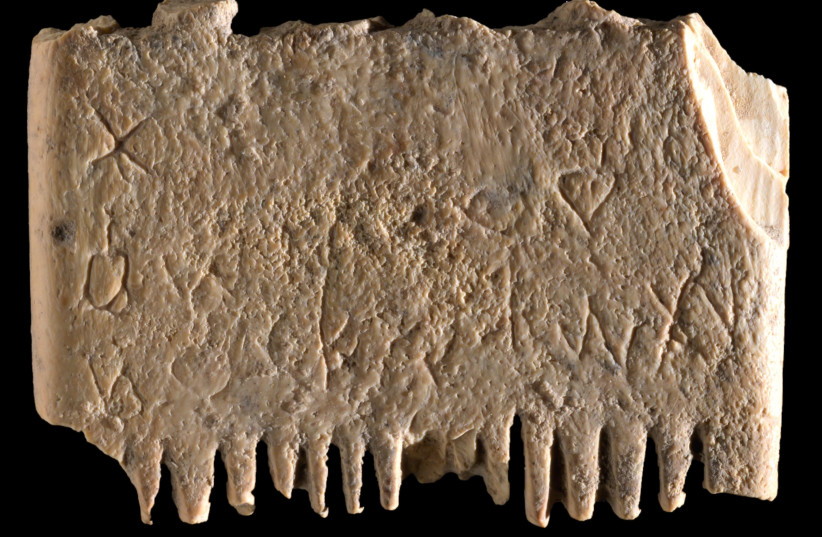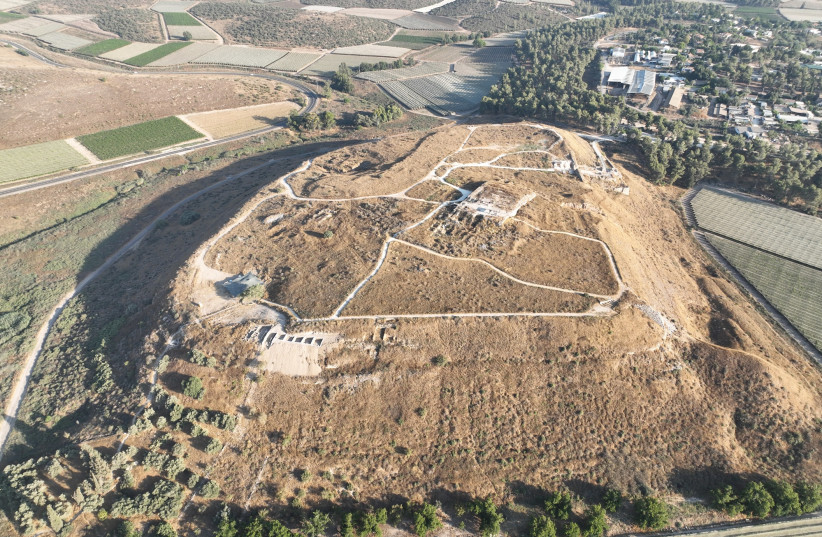 Israel unearths ivory comb from 1700 BCE inscribed with plea to stop lice
Israel unearths ivory comb from 1700 BCE inscribed with plea to stop lice
JUDY SIEGEL-ITZKOVICH
‘May this [ivory] tusk root out the lice of the hair and the beard’ is the first sentence written in the Canaanite language to be discovered at Tel Lachish.
.

(photo credit: DAFNA GAZIT/ISRAEL ANTIQUITIES AUTHORITY)
Ancient Canaanites suffered from lice, pediculus humanus capitis, on their beards and not just on their heads as do young children in Israeli schools today. The first sentence ever written in their language from 1700 BCE appears on an ivory comb inscribed with a hopeful plea to wipe out the lice: “May this [ivory] tusk root out the lice of the hair and the beard.”
The alphabet was invented around a century before and was used by the Canaanites and later included in most other languages in the world. Until recently, no meaningful Canaanite inscriptions had been discovered in the Land of Israel, except for two or three words here and there.
The comb was dug up at Israel’s Tel Lachish by a team from the Hebrew University of Jerusalem (HU) and Southern Adventist University in Tennessee under the direction of professors Yosef Garfinkel, Michael Hasel and Martin Klingbeil. The inscription was deciphered by semitic epigraphist Dr. Daniel Vainstub at Ben-Gurion University of the Negev (BGU) in Beersheba. The ivory was tested by HU Prof. Rivka Rabinovich and BGU Prof. Yuval Goren and found to originate from an elephant tusk.
Their findings were published in the peer-reviewed journal Jerusalem Journal of Archaeology under the title “A Canaanite’s Wish to Eradicate Lice on an Inscribed Ivory Comb from Lachish.”

Where was Lachish?
Lachish was an ancient Canaanite and Israelite city in the lowlands of Judea on the southern bank of the Lakhish River. It was mentioned several times in the Hebrew Bible. To date, 10 Canaanite inscriptions have been found there, more than at any other site in Israel. The city was the major center for the use and preservation of the alphabet for more than 600 years, from about 1800 BCE to 1150 BCE.
In the Book of Joshua, it is mentioned as one of the cities destroyed by the Israelites for joining the league against the Gibeonites (Joshua 10:31-33). The territory was later assigned to the tribe of Judah (15:39) and became part of the United Kingdom of Israel. Following the kingdom’s partition, Lachish emerged as one of the most important cities in the Kingdom of Judah, second only to the capital, Jerusalem.
Today, Lachish is a national park run and cared for by the Israel Nature and Parks Authority.
The letters of the inscription were engraved in a very shallow manner. It was excavated in 2017, but the letters were noticed only in subsequent post-processing in 2022 by Dr. Madeleine Mumcuoglu, a research associate at HU’s Institute of Archaeology. It was cleaned and preserved by Miriam Lavi.
The ivory comb is small, measuring roughly 3.5 by 2.5 centimeters. The comb has teeth on both sides. Although their bases are still visible, the comb teeth were broken in antiquity. The central part of the comb is somewhat eroded, possibly by the pressure of fingers holding the comb during haircare or removal of lice from the head or beard. The side of the comb with six thick teeth was used to untangle knots in the hair, while the other side, with 14 fine teeth, was used to remove lice and their eggs, much like the two-sided lice combs sold today in Israeli pharmacies and other stores.
There are 17 Canaanite letters – archaic in form from the first stage of the invention of the alphabet script – on the comb, and they form seven words in Canaanite.
“This is the first sentence ever found in the Canaanite language in Israel,” the researchers wrote. “There are Canaanites in Ugarit in Syria, but they write in a different script – not the alphabet that is used today. The Canaanite cities are mentioned in Egyptian documents, the Amarna letters that were written in Akkadian and in the Hebrew Bible. Amarna letters are an archive written on clay tablets primarily consisting of diplomatic correspondence between the Egyptian administration and its representatives in Canaan and Amurru or neighboring kingdom leaders, during the New Kingdom, spanning a period of just three decades from 1360 BCE.”
The comb’s inscription is direct evidence for the use of the alphabet in daily activities some 3,700 years ago.
“This is a landmark in the history of the human ability to write,” Garfinkel said.
Ancient combs were made from wood, bone or ivory, which was a very expensive material and likely an imported luxury object. As there were no elephants in Canaan during that time period, the comb likely came from nearby Egypt. These factors indicate that even people of high social status suffered from lice.
The research team analyzed the comb for the presence of lice under a microscope, and photographs were taken of both sides. Remains of head lice, 0.5 to 0.6 millimeters in size, were found on the second tooth. The climatic conditions of Lachish, however, did not allow the preservation of whole head lice but only those of the outer chitin (polymer) membrane of the nymph-stage head louse.
Despite its small size, the inscription on the comb from Lachish has very special features, some of which are unique and fill in gaps in our knowledge of many aspects of the culture of Canaan in the Bronze Age.
For the first time, we have an entire verbal sentence written in the dialect spoken by the Canaanite inhabitants of Lachish, making it possible for us to compare this language in all its aspects with the other sources for it. Second, the inscription on the comb sheds light on some aspects of the routine of life at the time that were unknown until now, including haircare and dealing with lice.
It is also the first discovery in the region of an inscription referring to the purpose of the object on which it was written, unlike dedicatory or ownership inscriptions on objects.
The engraver’s skill in successfully executing such tiny letters is a fact that from now on should be taken into account in any attempt to summarize and draw conclusions on literacy in Canaan in the Bronze Age, the archaeologists wrote.
Zawartość publikowanych artykułów i materiałów nie reprezentuje poglądów ani opinii Reunion’68,
ani też webmastera Blogu Reunion’68, chyba ze jest to wyraźnie zaznaczone.
Twoje uwagi, linki, własne artykuły lub wiadomości prześlij na adres:
webmaster@reunion68.com
